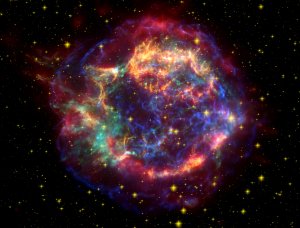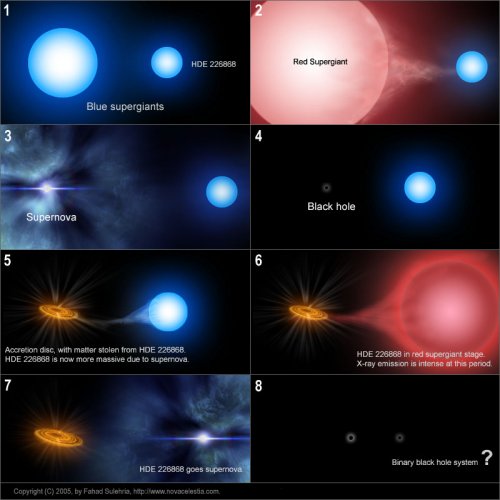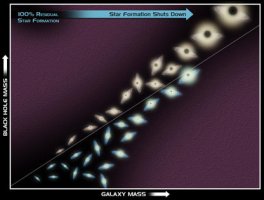Black hole creation and evolution
We recognize two major classes of black holes based on their mass. There are stellar mass black holes that have masses from few to at most several tens of the mass of Sun. Then there are supermassive black holes with masses greater than million solar masses.
Stellar-mass black holes
The stellar black holes arise as a final evolution stage of massive stars. The star has to have mass at least ten times larger than is the mass of Sun. This guarantees that after all the nuclear fuel has been consumed and the star explodes and casts off outer shells, there is still enough mass in its core with enough gravity to collapse into a black hole. The most massive stars have masses only up to about 500 solar masses otherwise they are not stable. It means that the most massive black hole of stellar origin can have a mass of about few hundred solar masses too.
 Most of the stars live in pairs as binaries or in some more complicated systems. Our Sun makes quite an exception here because only every fifth star in our Galaxy lives on its own without a companion. Imagine a binary system containing two heavy stars of quite similar but still different masses. The heavier star will evolve slightly more rapidly and will run out of fuel sooner. When that happens, it will explode as a supernova and likely create a black hole from what was left from its core. The other star, assuming it has been able to survive the cataclysmic explosion of its sister, will soon be getting to the end of its live too. For a brief period of time (it is brief from the point of view of the age of the star, but it may last millions of years), before it explodes as a supernova too, it will grow up in size and lower its surface temperature. At this stage it may become large enough for its outer shells to be gravitationally attracted by the black hole short distance away. Material from the star's surface will star to flow onto the black hole. Because the two objects orbit each other, the flow of the material is not straight, but is dragged by non-inertial Corriolis force and forms an accretion disk around the black hole. The gas is viscously heated and emits electromagnetic radiation of wavelengths corresponding to its temperature on the range from infrared to X-rays. This is the stage, when we can discover there is a black hole there and when we can observe it through its accretion disk. When the second star finishes and explodes, we may end up with a binary black-hole system or (depending on the original mass of the stars) with a black hole and neutron star system or with a binary neutron star.
Most of the stars live in pairs as binaries or in some more complicated systems. Our Sun makes quite an exception here because only every fifth star in our Galaxy lives on its own without a companion. Imagine a binary system containing two heavy stars of quite similar but still different masses. The heavier star will evolve slightly more rapidly and will run out of fuel sooner. When that happens, it will explode as a supernova and likely create a black hole from what was left from its core. The other star, assuming it has been able to survive the cataclysmic explosion of its sister, will soon be getting to the end of its live too. For a brief period of time (it is brief from the point of view of the age of the star, but it may last millions of years), before it explodes as a supernova too, it will grow up in size and lower its surface temperature. At this stage it may become large enough for its outer shells to be gravitationally attracted by the black hole short distance away. Material from the star's surface will star to flow onto the black hole. Because the two objects orbit each other, the flow of the material is not straight, but is dragged by non-inertial Corriolis force and forms an accretion disk around the black hole. The gas is viscously heated and emits electromagnetic radiation of wavelengths corresponding to its temperature on the range from infrared to X-rays. This is the stage, when we can discover there is a black hole there and when we can observe it through its accretion disk. When the second star finishes and explodes, we may end up with a binary black-hole system or (depending on the original mass of the stars) with a black hole and neutron star system or with a binary neutron star.

What we have described is just one of may possible ways how a stellar black hole may be created. That scenario is quite typical, but the details may differ depending on circumstances. It quite depends on masses of the original stars whether the system ends up as a binary black hole or a black hole and neutron star or as a binary neutron star. If two black holes are left, we can only learn about then with a gravitational wave detector. If a black hole and a neutron star are left and we are in addition lucky and the neutron star is a pulsar oriented towards Earth, we may detect its pulses with gradually increasing frequency, which is sign of a second massive component in the system. We may even be super-lucky and find a double pulsar where two neutron stars both become pulsars and in addition they are both oriented towards Earth so that we can measure pulses of both. Indeed such system were found and they serve us to indirectly confirm predictions of Einstein's theory of relativity.
Supermassive black holes
The supermassive black holes are substantially more massive and they are also much older. However, their origin is the same as the origin of stellar mass black holes. When the first stars were created from abundant dense clouds of hydrogen and helium in the early universe, they were heavy with masses of hundreds of solar mass. They also lived briefly because they burned the fuel fast and soon they turned into first black holes. The black holes were bigger and more numerous where the original gas cloud was heavier and smaller and less plentiful where the birth cloud was sparser. They acted on one another by their gravity, larger ones merging with smaller and growing in mass. Billions of years passed, universe had expanded, and the slightly larger black holes grew by continuously merging with smaller ones to enormous masses. They become local centers of gravity and formed whole galaxies around them. Today, we think based on good evidence that every galaxy holds one supermassive black holes in its very center with mass at least a million up to tens of billion of solar masses.



